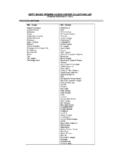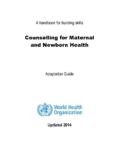Transcription of Nepal: Maternal Mortality and Morbidity Study 2008/09
1 This report summarizes preliminary key findings of the 2008/2009 Nepal Maternal Mortality and Morbidity Study (MMMS) which was implemented under the management of Family Health Division (FHD) of the Department of Health Services (DoHS), with technical support from Options UK, field implementation by New ERA, and research inputs from Centre for Research in Education Health and Population Activities (CREHPA). The Study was funded by the United States Agency for International Development (USAID), through their partners Macro International and JHPIEGO, with additional support from the UK Department for International Development (DFID) through the Support to the Safe Motherhood Programme (SSMP). The opinions expressed herein are those of the authors and do not necessarily reflect the views of the donors.
2 Additional information about the MMMS may be obtained from: Family Health Division, Department of Health Services, Government of Nepal; Teku, Kathmandu, Nepal. Telephone: (977-1) 4262273, 4262155, Email: Options Consultancy Services Ltd., 20-23 Grenville Street, London ECIN 855, United Kingdom. Telephone: 44(0) 20-7430-1900; Email: Suggested citation: Suvedi, Bal Krishna, Ajit Pradhan, Sarah Barnett, Mahesh Puri, Shovana Rai Chitrakar, Pradeep Poudel, Sharad Sharma and Louise Hulton. 2009. Nepal Maternal Mortality and Morbidity Study 2008/2009: Summary of Preliminary Findings. Kathmandu, Nepal. Family Health division, Department of Health Services, Ministry of Health, Government of Nepal. CONTENTS.
3 KEY FINDINGS. 1. INTRODUCTION .. 1. Rationale for the 1. Study 2. Study Area .. 2. Methodology .. 2. 2. FINDINGS .. 5. Number of Deaths among Women of Reproductive 5. Current levels of all-cause Mortality .. 5. Current levels of Maternal Mortality .. 5. Maternal Mortality ratio by age and ethnicity .. 6. Causes of Deaths of Women of Reproductive Age .. 6. All 6. Suicide .. 8. Maternal causes .. 9. Timing of Pregnancy Related 10. Place of Pregnancy Related Deaths .. 11. Hospital 11. Supply Side Factors .. 12. Delays at the 12. Referral .. 13. Analysis of hospital 13. Availability of services .. 16. Human resources .. 17. Infrastructure .. 18. Drug supplies and 19. Demand Side 19. Health seeking behaviour among pregnant and postpartum women.
4 19. Delays at community level .. 21. Factors influencing community decisions to seek 22. 3. CONCLUSIONS .. 24. LIST OF ACRONYMS. KEY FINDINGS. The overall Maternal Mortality Ratio (MMR) The percentage contributions of eclampsia, for the eight Study districts is 229 per 100,000 abortion related complications, gastroenteritis live births, ranging from 153 to 301 by and anaemia to Maternal causes have district. This is consistent with the 2006 Nepal increased, while those from obstructed labour Demographic and Health survey (NDHS) and puerperal sepsis have more than halved estimate of 281 per 100,000 live births. since 1998. Heart disease did not even feature in 1998, but now accounts for 7%. MMR variations: The MMR was lowest amongst women in their twenties, with Place: There was an increase in the increased risk for those aged under 20 and proportion of pregnancy related deaths between 30-34.
5 The figure for those aged over occurring in a health facility, to 41%; with 35 was considerably higher (962 per 100,000 40% occurring at home; and 14% in transit. In live births). There were also differences 1998 just 21% of deaths occurred in facilities between ethnic groups, with higher rates and 67% at home. among Muslims, Terai /Madhesi and Dalits. Timing: All non- Maternal pregnancy related Maternal causes accounted for 93% of deaths occurred during the antepartum pregnancy related deaths, giving an overall period. Many were unwanted pregnancies, pregnancy related Mortality ratio of 247 per suggesting the pregnancy status of the 100,000 live births and making this a good women may have placed them at greater risk.
6 Proxy indicator for Maternal Mortality . Of the Maternal deaths, 39% occurred during the intrapartum period and up to 48 hours Maternal causes accounted for 11% of all afterwards and 61% in the antepartum and deaths of women of reproductive age, in postpartum periods suggest that third place by ICD-X chapter; down from 21% interventions should focus more on this in 1998, when it was the leading cause by period. ICD-X chapter. Over 80% of women who died from Maternal There has been a dramatic increase in the causes were emergency admissions and in a contribution of suicide (16%) to deaths of critical state on admission: 18% died within women of reproductive age, compared with four hours of arrival, 39% within the first 10% in 1998.
7 This makes it the leading single twelve hours and 53% within the first 24. cause of death, whereas in 1998 it was third. hours. Direct causes accounted for 69% of all Supply side factors contributing to poor Maternal deaths and 31% were due to indirect Maternal outcomes included continued use of causes. The proportion of direct deaths is practices which are not evidence based, lack considerably higher when only hospital of appropriate staff; lack of essential drugs;. deaths are considered (89% direct; 11% weak referral systems and lack of blood. indirect). Community factors contributing to poor The percentage contribution of haemorrhage Maternal outcomes included delays in (24%) to Maternal causes has been recognising the problem and deciding to seek dramatically reduced, down from 41% in care; long distances to a health facility; lack of 1998.
8 However, it remains the leading cause finance and/or transport or time taken to of Maternal death, and the decline reflects a make arrangements; seeking care from the reduction in postpartum (from 37% to 19%), informal sector; not being able to or not rather than antepartum. wanting to seek care alone or needing permission to seek care. 1. INTRODUCTION. This Maternal Mortality and Morbidity (MMM) Study was carried out over the one-year period, 13. April 2008 to 13 April 2009, during which all deaths of women of reproductive age who were usual residents of eight districts of Nepal were identified and verbal autopsies carried out to determine the cause of death and contributory factors. All live births in these districts during the same period were also identified, enabling the calculation of a Maternal Mortality Ratio (MMR).
9 In this summary report we share the main findings of the Study from the data collected. Further details of methodologies, analysis and results can be found in the full report. The authors would like to wholeheartedly acknowledge the contribution of all verbal autopsy respondents who, despite their profound grief after a death in the family, gave generously of their time. We would also like to thank all the district based staff, health workers and female community health volunteers who assisted so ably with the field work. The names that appear in the case studies are pseudonyms to protect their privacy. Rationale for the Study In 1998, as part of the determined focus on Maternal Mortality , the first MMM Study was conducted in Nepal, to gain a better understanding of the causes of death of women of reproductive age, in particular those dying from Maternal causes.
10 At that time the MMR was estimated at 539 Maternal deaths per 100,000 live births1, and the report formed the basis of national safe motherhood programme interventions, planned and implemented by the Nepal government and national and international partners, aimed at reducing this unacceptably high figure. The 2006 Nepal Demographic and Health Survey (NDHS, 2006) indicated a substantial reduction in the MMR, to 281 deaths per 100,000 live births, indicating a degree of success in safe motherhood efforts, but also generating a good deal of discussion and debate regarding levels of and factors affecting Maternal Mortality in Nepal. This 2008/09 MMM Study was therefore initiated to further investigate the story behind the Maternal Mortality changes seen over the past 10 years, and to explore and identify contributory factors and their relative importance in different parts of the country.





